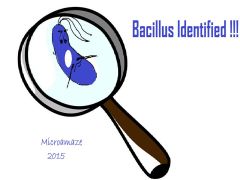![]()
![]()
![]()
Use LEFT and RIGHT arrow keys to navigate between flashcards;
Use UP and DOWN arrow keys to flip the card;
H to show hint;
A reads text to speech;
19 Cards in this Set
- Front
- Back
|
GeneralCharacteristics of Bacillus
|
Gram positive rod
spore former Produce endospores
a member of the phylum Firmicutes ~ 60 species; Gram-positive orGram-variable bacilli |
|
|
Habitat |
Ubiquitous, found everywhere!
Soil, water, and airborne dust
Most are saprophytic andare isolated as contaminants Others are opportunist |
|
|
What type of endospores does it create?
|
-Central endospores
- The spores are resistant to heat, cold, radiation, desiccation, and disinfectants and need oxygen |
|
|
What type of respiratory conditions may they require?
|
Aerobic or facultative anaerobic
|
|
|
Cell wall
|
-The cell wall is composed of teichoic and teichuronic acids.
-actin-like cytoskeleton in cell shape determination and peptidoglycan synthesis , - The role of the cytoskeleton in shape generation and maintenance is important |
|
|
History |
-The genus Bacillus was named in 1835 by Christian Gottfried Ehrenberg,
- earlier named as genus Bacterium |
|
|
Can flourish in what pH
|
Extreme pH - from pH 2-10
|
|
|
Optimum Temperature |
The optimum temperature for growth varies from 25°C to 37°C
|
|
|
Significant Bacillus Species
|
Bacillus anthracis- Agent ofanthrax, a disease in livestock .Humans acquireinfection by contamination of wound or ingestion or inhalation of spores
Bacillus cereus -Causes foodpoisoning .An opportunist Bacillus subtilis -Commonlaboratory contaminant |
|
|
virulence factors
|
hemolysin BL, ecithinaselike activity; phosphatidylcholine hydrolase ( phospholipase C.)
|
|
|
Pathology
|
cause an array of infections from ear infections to meningitis, and urinary tract infections to septicemia.
|
|
|
Clinical Manifestations
|
-Self limited food poisoning, localized infections related to trauma (e.g. ocular infections), deep seated soft tissue infections, and systemic infections (e.g. meningitis, endocarditis, osteomyelitis, and bacteremia).
Fulminant eye infections . The various species implicated in serious infections include B. cereus, B. subtilis, B. sphaericus, B. alvei, B. laterosporus, B. licheniformis, B.megaterium and B. pumilus. |
|
|
Laboratory Diagnosis
|
Most Bacillus spp grow readily on nutrient agar or peptone media. MYP agar,Mannitol-Eigelb-Polymyxin-Agar (Basis) ,Compass Bacillus cereus Agar
phage typing has been a useful epidemiological tool.A commercially available ELISA can be used for the detection of Bacillus diarrheal enterotoxin in a variety of foods and feces. |
|
|
How do Bacillus species look in Blood Agar?
|
-Large spreading colonies -Gray/white color -Have irregular margins
-Many are beta-hemolytic (helpful in differentiatingvarious Bacillus species from B. anthracis). |
|
|
complication
|
Endocarditis, Bacteremia ,Musculoskeletal Infections ,Meningitis
|
|
|
Industrial significance |
-Bacillus amyloliquefaciens is the source of a natural antibiotic
-protein barnase (a ribonuclease), -alpha amylase used in starch hydrolysis, -the protease subtilisin used with detergents, and -the BamH1 restriction enzyme -create GMOs Corns that are resistant to some insect pests. -Use as model organism |
|
|
Treatment |
clindamycin , Gentamicinand vancomycin
-Newer drugs e.g. imipenem , Doxycycline and quinolones |
|
|
PREVENTION
|
proper food handling.
|
|
|
Image |

For more information microamaze.blogspot.com
|

